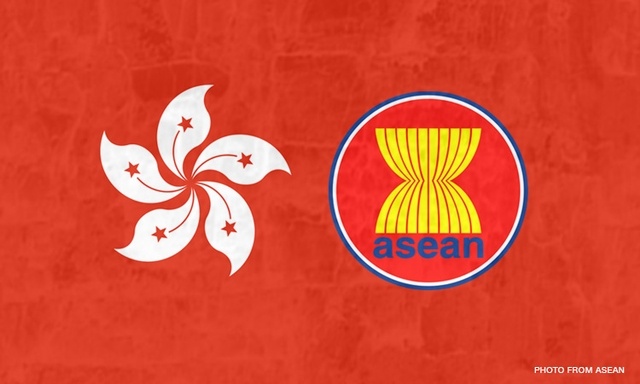
Feedback
Did you find what you were looking for?
Can we ask you a few more questions to help improve the VNTR?
 Hong Kong and ASEAN commenced negotiations of a Free Trade Agreement (AHKFTA) and a related Investment Agreement (AHKIA) in July 2014. After ten rounds of negotiations, Hong Kong and ASEAN announced the conclusion of the negotiations in September 2017. The FTA and the Investment Agreement (the Agreements) were signed on 12 November 2017.
Hong Kong and ASEAN commenced negotiations of a Free Trade Agreement (AHKFTA) and a related Investment Agreement (AHKIA) in July 2014. After ten rounds of negotiations, Hong Kong and ASEAN announced the conclusion of the negotiations in September 2017. The FTA and the Investment Agreement (the Agreements) were signed on 12 November 2017.
The Free Trade Agreement (AHKFTA) and the Investment Agreement (AHKIA) entered into force in full on 12 February 2021.
The Agreements are comprehensive in scope, encompassing trade in goods, trade in services, investment, economic and technical co-operation, dispute settlement mechanism and other related areas. The Agreements will bring legal certainty, better market access and fair and equitable treatment in trade and investment, thus creating new business opportunities and further enhancing trade and investment flows between Hong Kong and ASEAN.
The Agreements will also extend Hong Kong's FTA and Investment Agreement network to cover all major economies in Southeast Asia. They are expected to enter into force on 1 January 2019 the earliest, subject to completion of the necessary procedures.
Hong Kong (China) commits to eliminate 100% of tariffs on ASEAN goods as soon as the Agreement comes into effect. This commitment, although very liberal, does not fundamentally change the status because Hong Kong (China) has now eliminated taxes on almost 100% of the Tariff lines.
Vietnam commits to eliminate tariffs for 75% of tariff lines according to the 10-year schedule, 10% of tariff lines according to the 14-year schedule. This level can be said to be much more modest than Vietnam's tariff commitments in ASEAN (ATIGA).
Therefore, the meaning of AHKFTA is hardly in tariffs but mainly in utilizing Hong Kong (China) as a hub of logistics and financial transshipment.
Chapter 1: Establishment of the Free Trade Area, Objectives, General Definitions and Interpretations
Annex 2-1: Schedules of Tariff Commitments
Part 2: Schedule of Brunei Darussalam
Part 8: Schedule of the Philippines
Part 12: Schedule of Hong Kong, China
Annex 3-1: Operational Certification Procedures
Annex 3-2: Product Specific Rules
Annex 3-3: Product Specific Rules to be reviewed
Chapter 4: Customs Procedures and Trade Facilitation
Chapter 5: Sanitary and Phytosanitary Measures
Chapter 6: Standards, Technical Regulations and Conformity Assessment Procedures
Annex 8-1: Schedules of Specific Commitments
Chapter 9: Economic and Technical Cooperation
Chapter 10: Intellectual Property
Chapter 11: General Provisions and Exceptions
Chapter 12: Institutional Provisions
Chapter 13: Consultations and Dispute Settlement
Annex 13-1: Rules of Procedure for Arbitral Tribunal Proceedings
Investment Agreement and two related side agreements
Side Agreement with Brunei Darussalam, Malaysia and Singapore
General rules
A good will be considered originating (ASEAN or Hong Kong, China) if:
For case 3, the non-originating good in the Agreement is determined based on the following criteria:
Specific product rules
In addition to the general principles for determining the origin of goods, AHKFTA also stipulates specific rules for products in Appendix 3.2.
Cumulation
The AHKFTA allows for cumulation, i.e. originating materials of a member country used in the production of a good in another member country are treated as originating materials of the member country where the trade takes place processing of such goods.
Regarding services, Vietnam's commitment to open the service market in the AHKFTA is basically same the level in the WTO.
The investment commitment also reiterates the principles of conduct and protection for foreign investment similar to FTAs between ASEAN and its partners. The most notable commitment in the AHKFTA is the principle of fair and equal treatment (FET) for foreign investors, a principle emphasized in Vietnam's recent FTAs (CPTPP, EVFTA).
Ministry of Industry and Trade
Disclaimer: All information on this website is presented for consulation purpose only and does not constitute legal advice. All legal responsibility rests solely on the user. Users should not act upon any information obtained through this website without prior verigication with competent national authorities.
The website has been developed under Web Content Accessibility Guidlines (WCAG) 2
Viet Nam Ministry of Industry and Trade. All rights reserved.

Did you find what you were looking for?
Can we ask you a few more questions to help improve the VNTR?

0 of 12 answered


